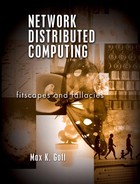Our notion of network computing is changing. We don't go to a single machine hoping that it can meet our needs. We use collaborating federations of sometimes invisible computers to access the services we want. As the network changes from client-server to multitier to interacting stacks of multitier networks and beyond, the way we interact with it also changes. Where once a single access point was the entrance to a particular network, the fractal future networks promise that every machine is an edge of a heterogeneous network without an easily defined boundary.
This book on Network Distributed Computing (NDC) isn't a destination—it too is an edge. It is a node in a fascinating ongoing discussion and discovery process. It is an entry point to a network of people and their ideas. You'll find a wealth of information culled from writings and history of computer science, biology, mathematics, philosophy, and other fields that prepares you for further exploration.
All the while, Max Goff keeps his focus on people and ideas. As he says, “Biologists are much more interested in microbes than in microscopes. Computers are tools at best and annoyances otherwise; for too long software developers have dwelt on the discipline-specific minutiae while ignoring big-picture implications that NDC finally presses to our noses, demanding resolution. If the computer industry itself is to be more than just a passing fad, outside-the-box visionaries must be given a fair hearing.”
I met Max Goff at a JavaOne BOF (Birds of a Feather) session that I led on Swarm computing. You can think of the popular wasp analogy. No wasp knows how to build a nest and yet collectively they do it. Simon Phipps suggests a metaphor of collaborating devices. Suppose, he says, that you are late for a breakfast meeting. Your PDA knows what time it is and what time your meeting is scheduled and where. Your GSA knows where you are, and so your GSA and PDA can together figure out that you're not going to make the meeting on time. They get your cell phone to contact your office computer and the machines of those you are meeting to reschedule the appointment.
Max contributed to the session with great questions and interesting scenarios. We kept bumping into each other at the rest of JavaOne. He was at the Jini community meeting and a ton of other sessions. Each time we'd meet up, he'd suggest another book that I should read. You'll find these recommendations and more in the reference material for this book.
I'm struck not just by what Max knows but also by his relentless quest to learn more. He's constantly looking around to see what's happening everywhere, driven by the admonition contained in Joy's Law that “Innovation occurs elsewhere.” As Max explains in the text, “No matter who you are, regardless of locale, financial well-being, intellectual property owned or clarity of vision, there are innovations occurring in other places, produced by entities beyond your own, which have impact upon the markets you serve and the work you do. Given the connected nature of a knowledge economy, any firm that denies the inevitability of innovations occurring elsewhere is doomed to fail.”
Network distributed computing requires that we change our notion of how to write programs. We need to think differently about what we can control as well as about what we can accomplish. We interact with computers without being aware of their presence and contributions. While being excited by the promise of new technologies, Max keeps his eye on the ball. He quotes Weiser's principles of pervasive computing, reminding us that “the computer should extend your unconscious and technology should create calm.”
After all of the books that Max has recommended I read, I am happy to recommend his book to you. He is a technologist who loves to communicate his passion and understanding. Communication doesn't mean writing or talking any more than teaching means standing up in front of a class a lecturing. I can't resist one more quote from this interesting book that you hold. Max understands that “Communication . . . represents not only the transmission of information but the receipt and ultimate understanding of it as well.” Welcome to the discussion.
Daniel H. SteinbergDirector of Java OfferingsDIM SUM ThinkingandEditor of java.net and ONJava.com
